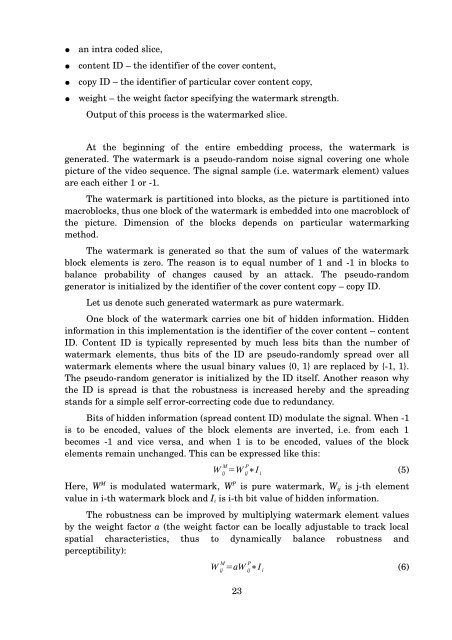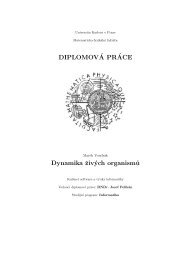MASTER THESIS Video Watermarking - Computer Graphics Group ...
MASTER THESIS Video Watermarking - Computer Graphics Group ...
MASTER THESIS Video Watermarking - Computer Graphics Group ...
You also want an ePaper? Increase the reach of your titles
YUMPU automatically turns print PDFs into web optimized ePapers that Google loves.
an intra coded slice,<br />
content ID – the identifier of the cover content,<br />
copy ID – the identifier of particular cover content copy,<br />
weight – the weight factor specifying the watermark strength.<br />
Output of this process is the watermarked slice.<br />
At the beginning of the entire embedding process, the watermark is<br />
generated. The watermark is a pseudo-random noise signal covering one whole<br />
picture of the video sequence. The signal sample (i.e. watermark element) values<br />
are each either 1 or -1.<br />
The watermark is partitioned into blocks, as the picture is partitioned into<br />
macroblocks, thus one block of the watermark is embedded into one macroblock of<br />
the picture. Dimension of the blocks depends on particular watermarking<br />
method.<br />
The watermark is generated so that the sum of values of the watermark<br />
block elements is zero. The reason is to equal number of 1 and -1 in blocks to<br />
balance probability of changes caused by an attack. The pseudo-random<br />
generator is initialized by the identifier of the cover content copy – copy ID.<br />
Let us denote such generated watermark as pure watermark.<br />
One block of the watermark carries one bit of hidden information. Hidden<br />
information in this implementation is the identifier of the cover content – content<br />
ID. Content ID is typically represented by much less bits than the number of<br />
watermark elements, thus bits of the ID are pseudo-randomly spread over all<br />
watermark elements where the usual binary values {0, 1} are replaced by {-1, 1}.<br />
The pseudo-random generator is initialized by the ID itself. Another reason why<br />
the ID is spread is that the robustness is increased hereby and the spreading<br />
stands for a simple self error-correcting code due to redundancy.<br />
Bits of hidden information (spread content ID) modulate the signal. When -1<br />
is to be encoded, values of the block elements are inverted, i.e. from each 1<br />
becomes -1 and vice versa, and when 1 is to be encoded, values of the block<br />
elements remain unchanged. This can be expressed like this:<br />
<br />
<br />
<br />
Here, W M is modulated watermark, W P is pure watermark, Wij is j-th element<br />
value in i-th watermark block and Ii is i-th bit value of hidden information.<br />
The robustness can be improved by multiplying watermark element values<br />
by the weight factor a (the weight factor can be locally adjustable to track local<br />
spatial characteristics, thus to dynamically balance robustness and<br />
perceptibility):<br />
<br />
<br />
<br />
23<br />
(5)<br />
(6)
















